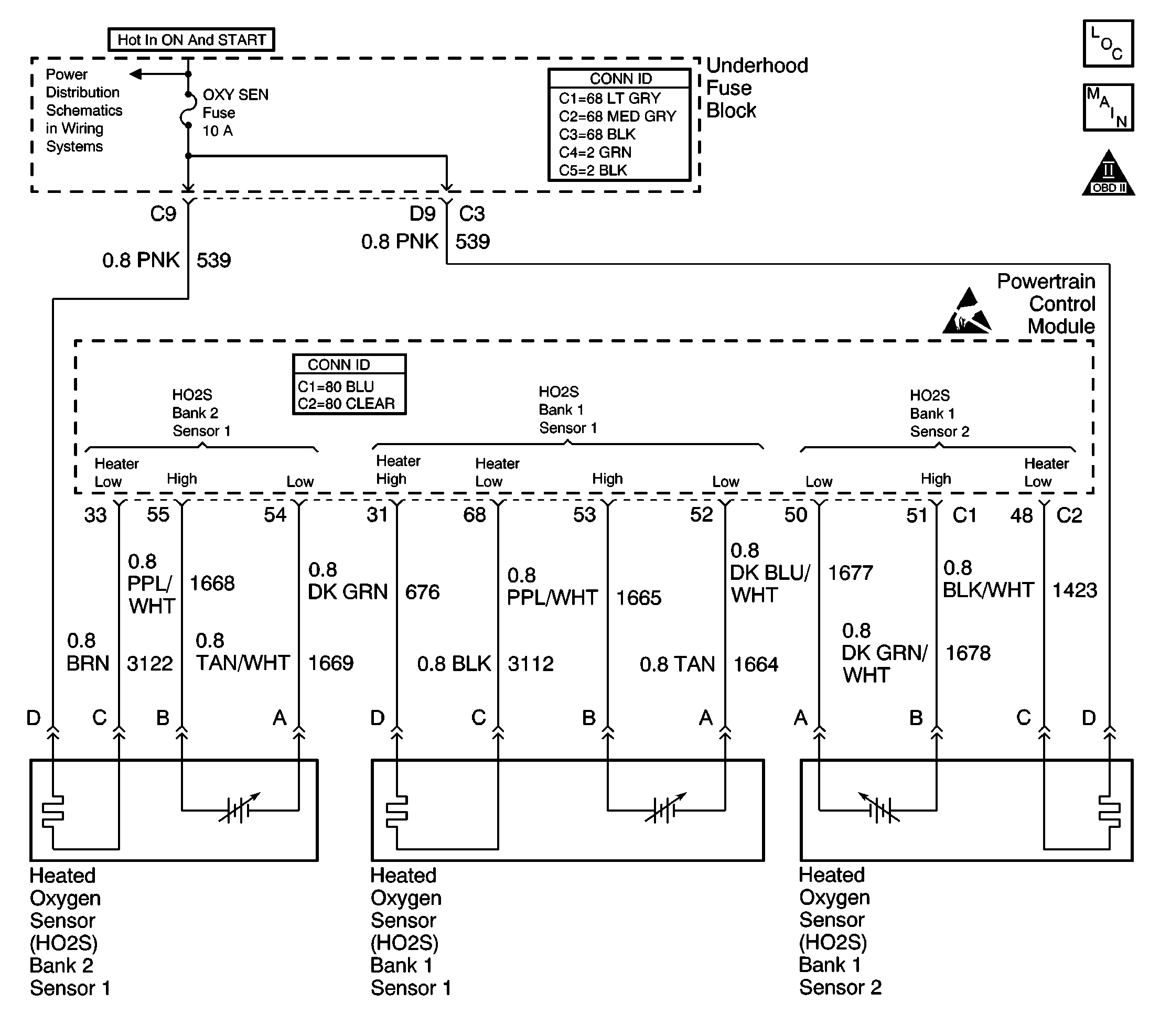
Circuit Description
The HO2S is a sensor used to detect oxygen-content in the exhaust. The PCM supplies the sensor with a signal circuit and a ground circuit. The PCM supplies a bias voltage between the circuits. The sensor varies the voltage based on the oxygen content in the exhaust. When the exhaust stream is lean (more oxygen), the sensor produces a low voltage signal. When the exhaust stream is rich (less oxygen), the sensor produces a high voltage signal. The PCM monitors the HO2S signal during closed loop. To correct for rich or lean conditions, the PCM adjusts the injector pulse width. If HO2S bank 1 sensor 2 remains too high for a calibrated period of time, DTC P0138 will set.
Conditions for Running the DTC
| • | TP sensor, MAF sensor, MAP sensor, IAT sensor, ECT sensor, EVAP system, AIR system (if equipped), fuel injector, EGR system DTCs are not set |
| • | TP angle is between 3 percent and 25 percent |
| • | System voltage is between 9 and 18 volts |
| • | Closed loop fuel control is enabled |
| • | Air fuel ratio is between 14.4 and 14.9 |
| • | Catalyst test inactive |
| • | AIR test inactive |
| • | The conditions above are met for 5 seconds. |
Conditions for Setting the DTC
HO2S bank 1 sensor 2 signal voltage remains above 950 mV (0.95 V) for approximately 112 seconds.
OR
HO2S bank 1 sensor 2 signal voltage remains above 200 mV (0.2 V) for approximately 11 seconds.
Action Taken When the DTC Sets
| • | The PCM illuminates the malfunction indicator lamp (MIL) during the second consecutive trip in which the diagnostic test runs and fails. |
| • | The PCM stores the conditions present when the DTC set as Freeze Frame/Failure Records data. |
Conditions for Clearing the MIL/DTC
| • | The PCM will turn the MIL OFF after the third consecutive trip in which the diagnostic runs and passes. |
| • | The history DTC will clear after 40 consecutive warm-up cycles have occurred without a malfunction. |
| • | The DTC can be cleared by using the scan tool Clear DTC Information function. |
Diagnostic Aids
Notice: Do not solder heated oxygen sensor wires. Soldering the wires will result in the loss of the air reference to the sensor. Refer to Engine Electrical for proper wire and connection repair techniques.
Check the following items:
| • | HO2S wire routing -- The sensor wiring may be routed incorrectly and contacting the exhaust system. |
| • | Silicon contamination -- Silicon contamination of the HO2S sensor can also cause a high HO2S signal voltage. This condition is indicated by a powdery white deposit on the portion of the HO2S exposed to the exhaust stream. |
If the condition is intermittent, refer to Intermittent Conditions .
Test Description
The numbers below refer to the step numbers on the diagnostic table.
-
Verifies whether or not the HO2S sensor voltage is switching from below 300 mV to above 600 mV, or remaining above 950 mV.
-
Verifies the bias voltage from the PCM and the condition of the circuit wiring. With the sensor disconnected, the scan tool should display a bias voltage near 450 mV.
Step | Action | Values | Yes | No | ||||||
|---|---|---|---|---|---|---|---|---|---|---|
1 | Did you perform the Powertrain On Board Diagnostic (OBD) System Check? | -- | Go to Step 2 | |||||||
Does voltage remain above the value specified? | 950 mV | Go to Step 4 | Go to Step 3 | |||||||
3 |
Does the scan tool indicate that DTC P0138 failed last test? | -- | Go to Step 4 | Go to Diagnostic Aids | ||||||
Does the scan tool display an HO2S bank 1 sensor 2 voltage near the specified value? | 450 mV | Go to Step 6 | Go to Step 5 | |||||||
5 |
Did you find and correct the condition? | -- | Go to Step 8 | Go to Step 7 | ||||||
6 |
Important: If the sensor appears contaminated, correct the source of the oxygen
sensor contamination before replacing the sensor in order to prevent future
contamination. Typical contamination sources include the following:
Replace the bank 1 sensor 2 heated oxygen sensor. Refer to Heated Oxygen Sensor Replacement - Bank 1 Sensor 2 Is the action complete? | -- | Go to Step 8 | -- | ||||||
7 |
Important: The replacement PCM must be programmed. Replace the PCM. Refer to Powertrain Control Module Replacement/Programming . Is the replacement complete? | -- | Go to Step 8 | -- | ||||||
8 |
Does the scan tool indicate that DTC P0138 passed? | -- | System OK | Go to Step 2 |
